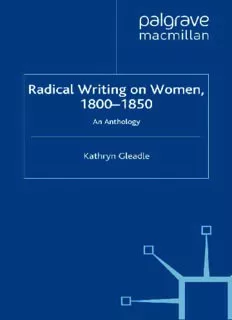
Radical Writing on Women, 1800–1850: An Anthology PDF
Preview Radical Writing on Women, 1800–1850: An Anthology
Radical Writing on Women, 1800–1850 This page intentionally left blank Radical Writing on Women, 1800–1850 An Anthology Kathryn Gleadle British Academy Post-Doctoral Research Fellow London Guildhall University © Kathryn Gleadle 2002 All rights reserved. No reproduction, copy or transmission of this publication may be made without written permission. No paragraph of this publication may be reproduced, copied or transmitted save with written permission or in accordance with the provisions of the Copyright, Designs and Patents Act 1988, or under the terms of any licence permitting limited copying issued by the Copyright Licensing Agency, 90 Tottenham Court Road, London W1T 4LP. Any person who does any unauthorised act in relation to this publication may be liable to criminal prosecution and civil claims for damages. The author has asserted her right to be identified as the author of this work in accordance with the Copyright, Designs and Patents Act 1988. First published 2002 by PALGRAVE MACMILLAN Houndmills, Basingstoke, Hampshire RG21 6XS and 175 Fifth Avenue, New York, N.Y. 10010 Companies and representatives throughout the world PALGRAVE MACMILLAN is the new global academic imprint of the Palgrave Macmillan division of St. Martin’s Press, LLC and of Palgrave Macmillan Ltd. Macmillan®is a registered trademark in the United States, United Kingdom and other countries. Palgrave is a registered trademark in the European Union and other countries. ISBN 978-0-333-72613-6 ISBN 978-0-230-28670-2 (eBook) DOI 10.1057/9780230286702 This book is printed on paper suitable for recycling and made from fully managed and sustained forest sources. A catalogue record for this book is available from the British Library. Library of Congress Cataloging-in-Publication Data Radical writing on women, 1800–1850: an anthology / [compiled by] Kathryn Gleadle. p. cm. Includes bibliographical references and index. ISBN 978-0-333-72613-6 1. Women—History—19th century. 2. Women—History—19th century—Sources. 3. Women—Social conditions—19th century. 4. Feminism—History—19th century. 5. Sex role—History— 19th century. I. Gleadle, Kathryn. HQ1154 .R28 2002 305.4’09’034—dc21 2002019512 10 9 8 7 6 5 4 3 2 1 11 10 09 08 07 06 05 04 03 02 Contents Acknowledgements vii Notes on the Text viii Introduction 1 Part I Defining the Problem Introduction 21 1 Analysing Woman’s Position 26 2 Agendas for Change 42 Part II Female Roles Introduction 55 3 Education 61 4 Employment 77 5 Domesticity and Motherhood 96 Part III Marriage, Sexuality and the Female Body Introduction 111 6 Reforming Marriage 117 7 Divorce and Sexual Radicalism 129 8 Female Sexuality and the Female Body 142 Part IV Political Rights and Public Power Introduction 155 9 Female Rights, Popular Politics and Electoral Reform 159 10 Middle-Class Reform Projects 175 Biographical Notes 193 Bibliography 220 Index 233 This page intentionally left blank Acknowledgements The following libraries kindly permitted me to quote from material in their care: the British Library of Political and Economic Science; the Syndics of Cambridge University Library; The Mistress and Fellows, Girton College, Cambridge; Birmingham City Archives; the Friends House Library, London; and the Working-Class Movement Library, Salford. My thanks also to Helen Plant and Jane Rendall for allowing me to cite from their unpublished papers. In common with all others working in this field, I owe a tremendous debt to Jane Rendall for her inspiration and kind support. I wish to thank the British Academy for their financial support; and London Guildhall University for providing a welcoming academic home during the closing stages of this project. I am extremely grateful to Clare Midgley and Sarah Richardson for their encouragement and advice. Helen Rogers has been patient, kind and supportive and valiantly read an early and chaotic draft. Philippa Gray’s friendship, wine-drinking and irreverence were particularly appreciated as the book reached completion. Finally, my family have nobly endured my continuing passion for early nineteenth-century feminism and its consequent incursion into our lives. vii Notes on the Text Original spellings and punctuation have been retained, although obvious errors have been silently corrected. Bracketed numbers in the main body of the text refer to documents in the anthology. viii Introduction It has become a commonplace of feminist history that in the politi- cally repressive climate of the post-revolutionary years, the voice of Mary Wollstonecraft was silenced. The fate of her reputation was apparently sealed in 1798 when William Godwin’s revealing memoirs brought to light her suicidal tendencies and the nature of her rela- tionship with Gilbert Imlay. According to the conventional narrative, this moment signalled a closure in the articulation of revolutionary feminism, as female authors were constrained to forget the lessons Wollstonecraft had taught them. They must bow their heads and succumb to a new, restrictive cultural order.1 However, it is now becoming increasingly apparent that such a picture requires considerable modification. As this collection seeks to demonstrate, feminism was alive and kicking in early nineteenth- century Britain. Indeed, to many it was a palpable threat. Witness Lord Shaftesbury during a debate on Jewish emancipation fearing that ‘perhaps they would have a final struggle for a male Parliament’;2 or consider the hysterical tone of the British and Foreign Quarterly Review which portrayed Caroline Norton’s campaign for greater maternal custody rights as a treacherous bid by female emancipationists to loosen all social ties.3 Contemporary periodical publications could point to a continuing, rich vein of feminist discourse, citing such writers as Catherine Macaulay, Mary Wollstonecraft, William Thompson, Anna Jameson and Harriet Martineau.4Indeed, the preva- lence of feminism was such that a women’s rights position could be parodied, alluded to and satirized in contemporary literature. Both Charles Dickens’s Dombey and Son and William Thackeray’s Vanity Fair, for example, introduce cameo feminist characters.5 In tracing the history of early nineteenth-century feminism, two 1 K. Gleadle, Radical Writing on Women, 1800–1850 © Kathryn Gleadle 2002
Description: